Bounce rate. Two words that strike fear into website admins everywhere. The idea that people come to your site, glance at your content, and then leave without interacting is everyone’s worst-case scenario. You can’t control people leaving your site. Eventually, everyone will leave. But there’s a different in your exit rate (which is unavoidable) and bounce rate (which you can do some things to manage). Let’s break down the concept and dig into how you can keep bounce rate low and conversions high.
Subscribe To Our Youtube Channel
What is Bounce Rate?
A bounce is a single-page session on your site. In Analytics, a bounce is calculated specifically as a session that triggers only a single request to the Analytics server, such as when a user opens a single page on your site and then exits without triggering any other requests to the Analytics server during that session.
Basically, when a user comes in, looks around, and leaves without doing anything at all. No clicks, no scrolls, no conversions. Just in and out. Sure, these people may trigger ad impressions (but again no clicks!), but their benefit to you stops there.
Bounce rate, then, is the rate at which people bounce into and out of your site without interacting. Exit Rate is the rate at which people leave your site, period, each of which has a different page that completes their visit. You can track their user journey and path through your site so you can see what they’re interested in and when they left.
But bounces…you can’t really get much useful information about them.
But Is a High Bounce Rate Bad?
No. Not necessarily. Also yes, it can be. It all depends on the purpose of the page. Read that again the page. Not the site. Having a site-wide bounce rate be pretty high doesn’t really tell you anything. It may show that people stumble on your category archives, author bios, random archive blog post, or About page and leave. When combined into an average, knowing that you have a 75%+ bounce rate is relatively useless.
Because what does it tell you? That 75% of the people who visit your site leave. But how do you fix it? Why do they leave? There’s no way to tell for two reasons:
- You have no information other than that they left your site. Not any specific pages.
- You have no information on why they came to your site in the first place. So while the bounce rate might be high, your site could still be fulfilling its purpose.
So, as with most things regarding our sites, let’s turn to Google Analytics to figure out what’s really going on and how we can lower our bounce rate. But do it in a way that matters.
Using Google Analytics
To check your overall bounce rate in GA, you’ll navigate to Behavior – Overview and see a box labeled Bounce Rate.
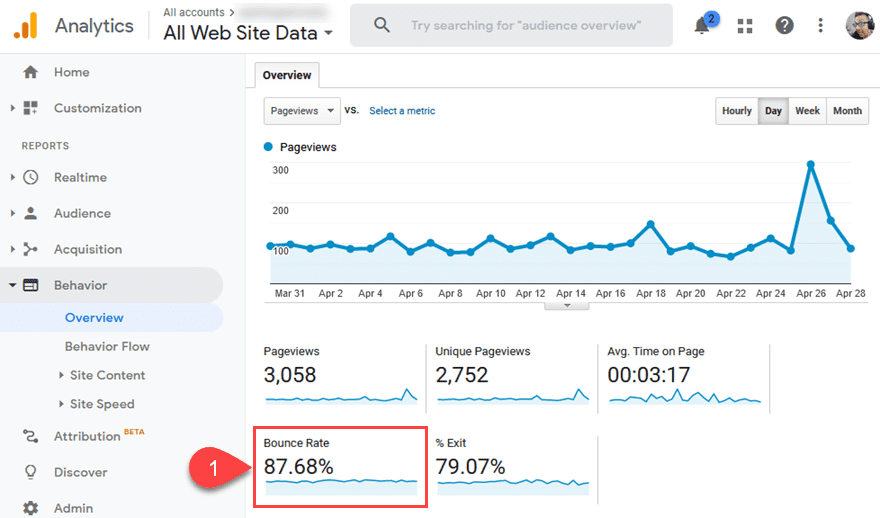
Since this is the overview of your stats, this particular percentage is for the entire site. It doesn’t tell you a lot of information, just that the majority of people bounce before interacting.
Now, as we said above, you will need to drill down a bit to get any data that you can use to take actionable steps toward improving your bounce rate. After all, there’s a big difference between the readers of your blog and the customers at your eshop. GA will let you drill down, but first you need to figure out something important: search intent.
Does installing Google Analytics seem daunting? Look into these helpful plugins for installing Google Analytics and tracking site interactions.
What is Search Intent?
Put simply, it’s the reason that people landed on your site in the first place. If a person Googles do my feet shrink when I lose weight? and they land on a product page for your eCommerce shoe store, that page isn’t fulfilling the intent of their search.
So they bounce. If 99 out of 100 people do that, even though your overall site has a 75% bounce rate, that particular page has a 99% bounce rate.
See how that works? Easy peasy.
Now, if they land on your blog post titled Yes, Your Feet Shrink When You Lose Weight, then your post absolutely fulfills their search intent. But what if 90% of people bounce from it, too? What gives?
What that means is that while your blog post incentivizes people to click into it and read and satisfies everything about their search intent, you haven’t incentivized them to interact with your site in a way that adds additional value to why they came there in the first place.
For instance, perhaps a pop up that asks them to opt-in to your ecommerce shoe store mailing list so that when their feet shrink, they have options available immediately. Or perhaps a link to another blog post on shoe sizing that paths them deeper into your site. Those could potentially lower your bounce rate from 90%+ down to 40-55%.
But in order to find these pages to optimize to lower bounce rate and determine the search intent, we need to look into Google Analytics.
Finding Your Bounced Pages
There are a number of ways in Google Analytics to find which pages are bounced from. We like a more visual method rather than standard numbers in spreadsheet-like cells. That means we are going to use the Users Flow chart. You can find it under Audiences – User Flow from the left-hand menu.
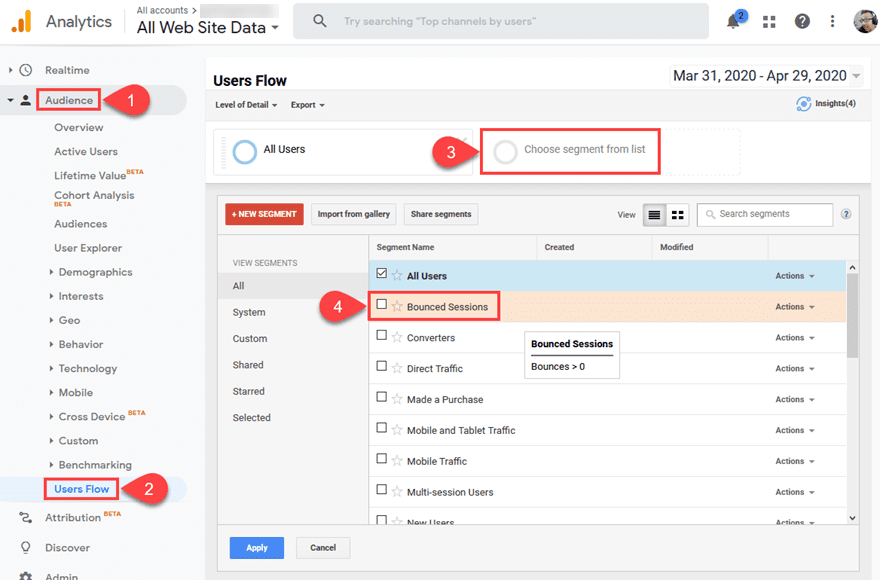
The initial user-flow chart can help a lot, but we want to add a segment to the graph. So click on Add Segment, and that will turn into Choose Segment From List. Then you just click on Bounced Sessions to make it appear in the charts.
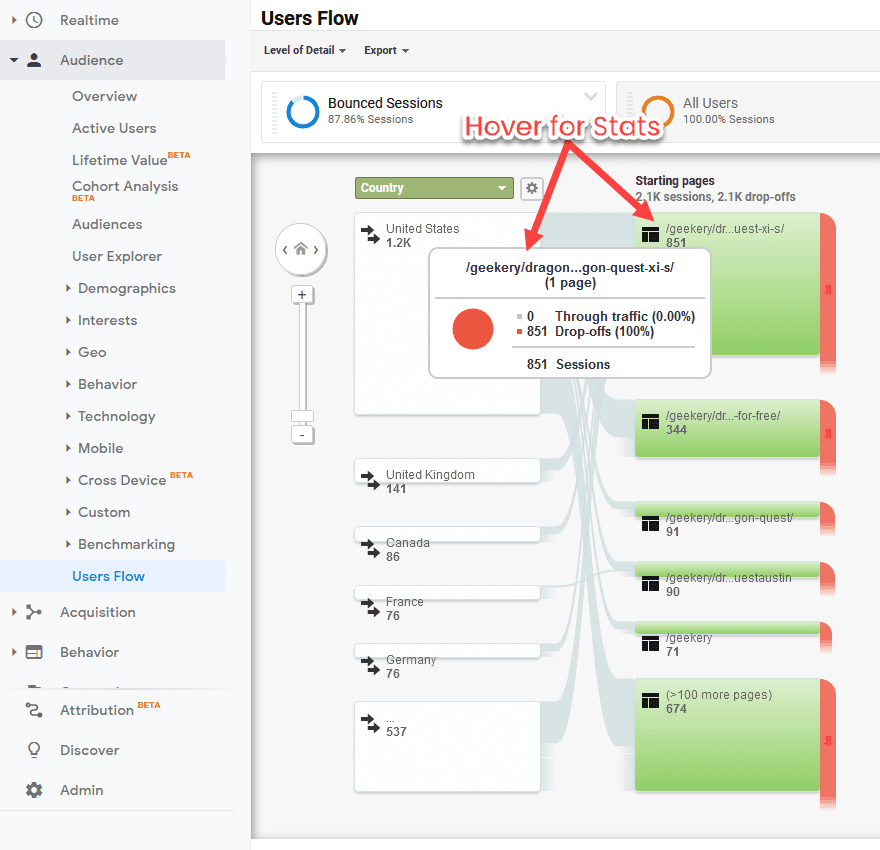
All you have to do is hover over the green area to see which particular pages have been bounced from. You will see the summary of number of bounces by default. You can drill down by hovering. In this view, you will see the drop-off at 100% and through traffic at 0%. That’s your bounce rate from these pages. These are exactly the pages that people are bouncing from.
But you should note that these pages under the Bounce Rate tab are only the landing pages for visitors. They didn’t click on anything. So you will be able to make decisions on why they leave.
And if you want to see what pages the users flow to and click through to, click on All Users. You will see the user journey through your site and their exit pages, plus you can then see the rates at which they leave these pages, too. You can set any amount of flow depth you want, but there are diminishing returns on trying to prevent exits from a user’s 5th page versus their 2nd.
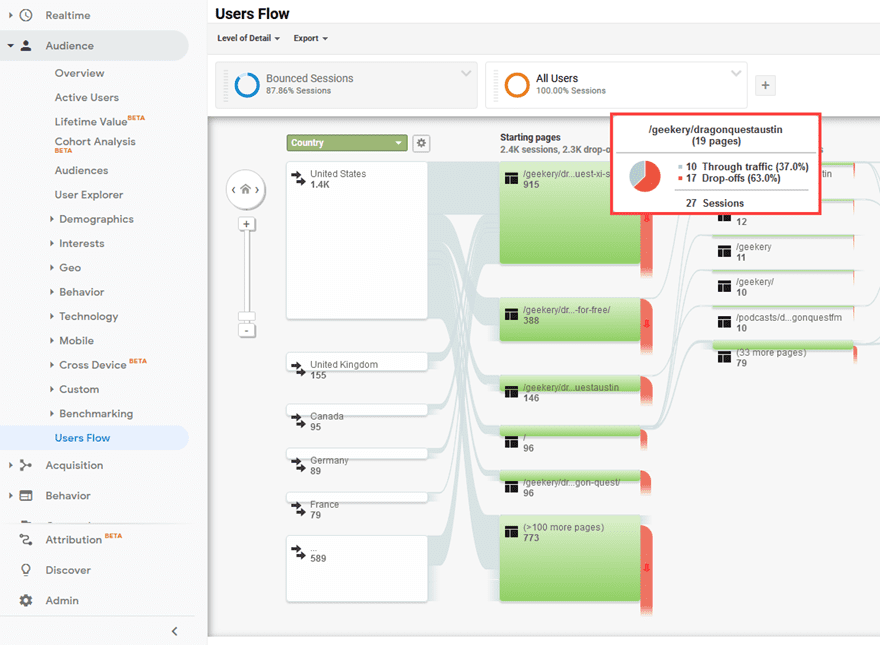
In the first example above, the top bounced page is a blog post about how to beat an optional boss in a video game. The page itself 100% satisfies the user’s search intent. So…the readers bounce off the site. In the second screenshot, the flow shows users going back to that blog’s homepage, but 63% of users not clicking into another post.
This is the point at which you need to determine how you can keep these users engaged. Especially for those who bounce from the very first page, even with their search intent fulfilled. When looking at the second-page exit, we can (generally) assume two things: the search intent was fulfilled but left them wanting more information they may not have found, or their search intent was not fulfilled by either page, causing them to leave.
Methods to Lower Bounce Rate
There is no quick-fix, magic bullet to lowering your bounce rate. However, there are some tried-and-true methods that tend to work to increase engagement with your users and gets them to convert into members of your community.
Optimize Page Speed
While this isn’t tied directly to your bounce rate, one of the primary reasons that users leave your site is because they simply can’t access the content quickly enough. If your page doesn’t load in under 3 seconds (or 1, in ideal circumstances), they’re likely to bounce. You can lower your page speed by optimizing your images, removing excess JavaScript, minifying the markup and other code in the site, and caching the site using any number of plugins.
Call the Users to Action with CTAs
Regardless of how you do it, creating meaningful calls to action is probably the best way to reduce bounce rate. Using the right colors (orange and red, maybe, instead of black or white for buttons), larger sizing to call attention to them, that sort of thing. Landing page plugins have an arsenal of modules and elements that you can employ on your pages to make them more appealing to your visitors. While you don’t want to be obnoxious and insincere with your CTAs, you do want them to be noticeable and (hopefully) unignorable. Whatever fits that page or site. Try a persistent banner at the top of the page, or use pop-ups that only appear as they are going to bounce. A slide-in email subscribe window in the corner. Even a live chat box or AI bot to keep them engaged.
Conduct A/B Tests
You can conduct A/B tests on a number of different elements to attempt to lower your bounce rate. Create two versions of your layout, then serve them to different audiences to determine which one drives engagement and conversion. You have a number of options at your disposal, and Divi users have even more. We even have A/B testing for layouts built right into our builder.
Not only can you do it with templates and layouts and various designs, but A/B testing can be done on pop-ups and CTAs, too. Try out different methods to grab visitors’ attention at different points on the page, different timings, and maybe different conversion goals and locations to see what draws your users in.
Create Better, More Engaging Content
This is not a dig at you. We are not saying that you’re creating anything less than superb content. What we are saying is that you might need to change up your strategy to keep people from bouncing. Maybe you need more headlines to make the posts and pages more scannable (people bounce from Walls of Text often). Perhaps more images (or infographics) would lead to more social shares.
Or it could just be a case of needing to work on your content creation strategy. Maybe a differnet tone for your articles would keep people reading. Could you get to the point sooner keep readers? Don’t bury the lede. Get to the point quickly and succinctly and then explain it. Don’t lead up to it and hope your reader gets to the point at the end. Spoiler alert: they won’t.
Wrapping Up with Bounce Rate
In the end, there’s no reason to be scared of bounce rate. It could mean that your site is doing exactly what you set out to do. But by performing a little analysis and looking at what pages your users bounce from, you can create an even better experience for them. If your site is slow, dull, or poorly laid out, people will leave. But those are fairly easy fixes, and the biggest thing is to be aware of your users’ behavior and account for it. Run some tests, create some pop-ups and fantastic articles, and you’re sure to convert people from visitors to members.
What strategies have you employed to reduce bounce rate?
Article featured image by BRO.vector / shutterstock.com








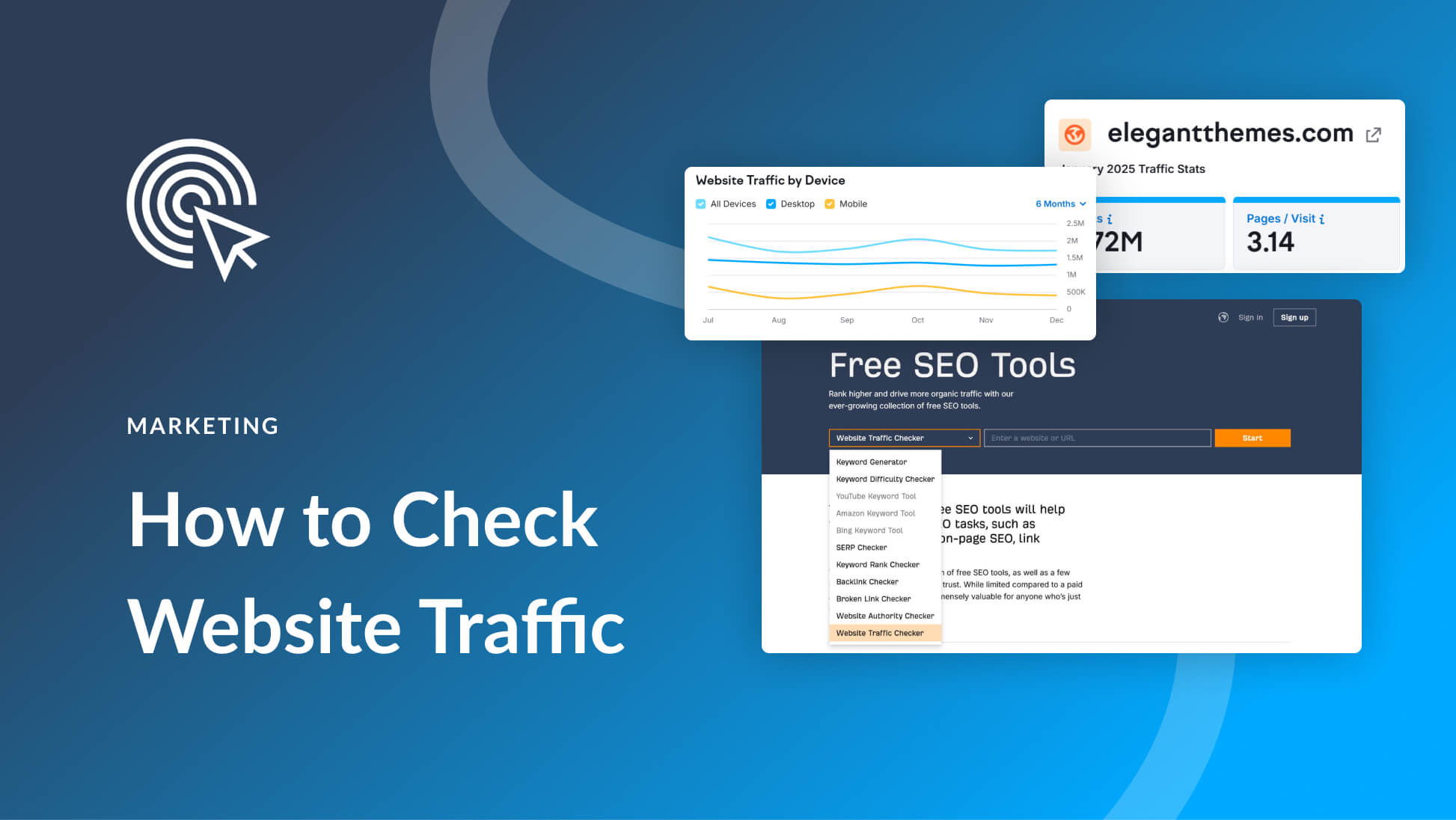
Great content! Super high-quality! Keep it up!